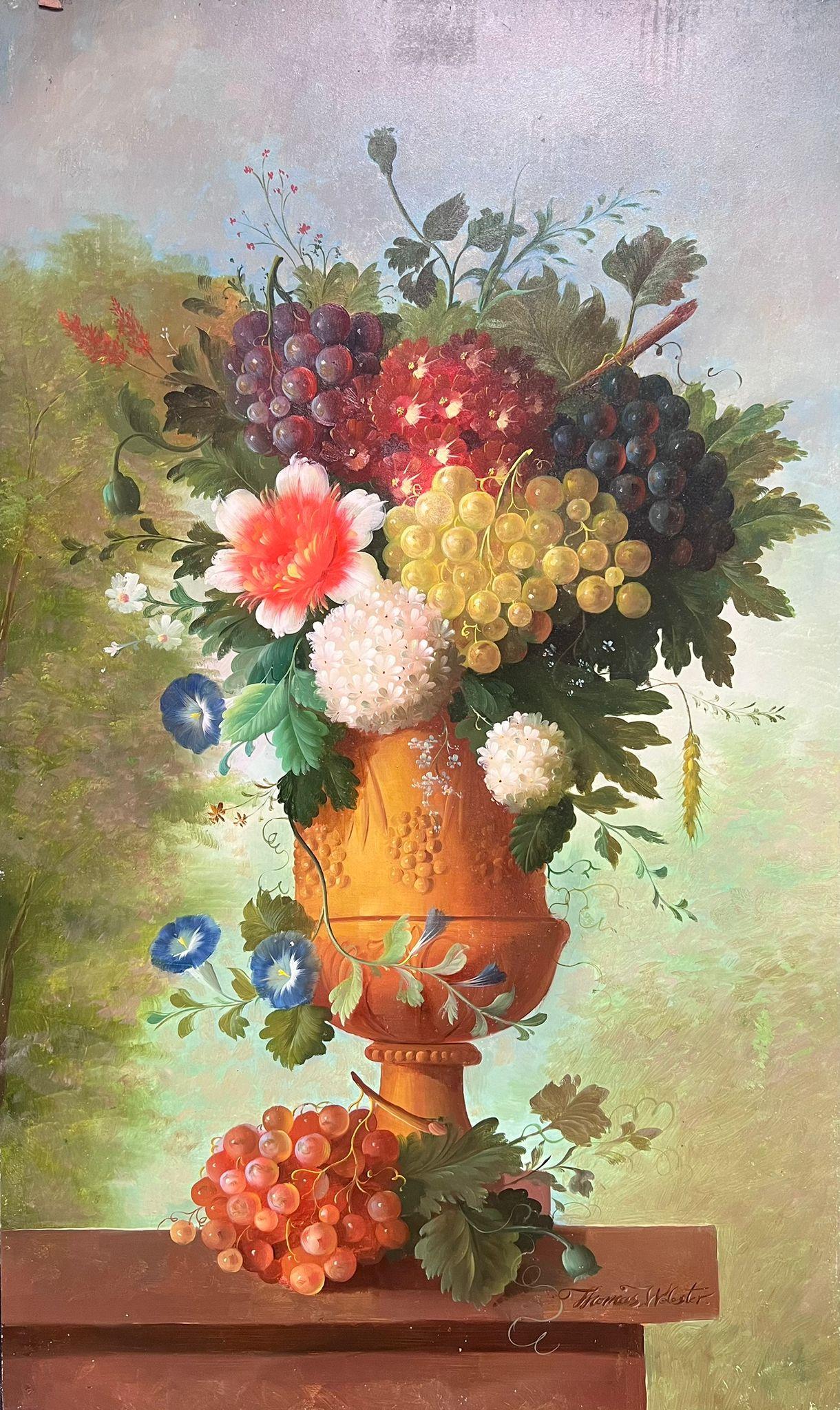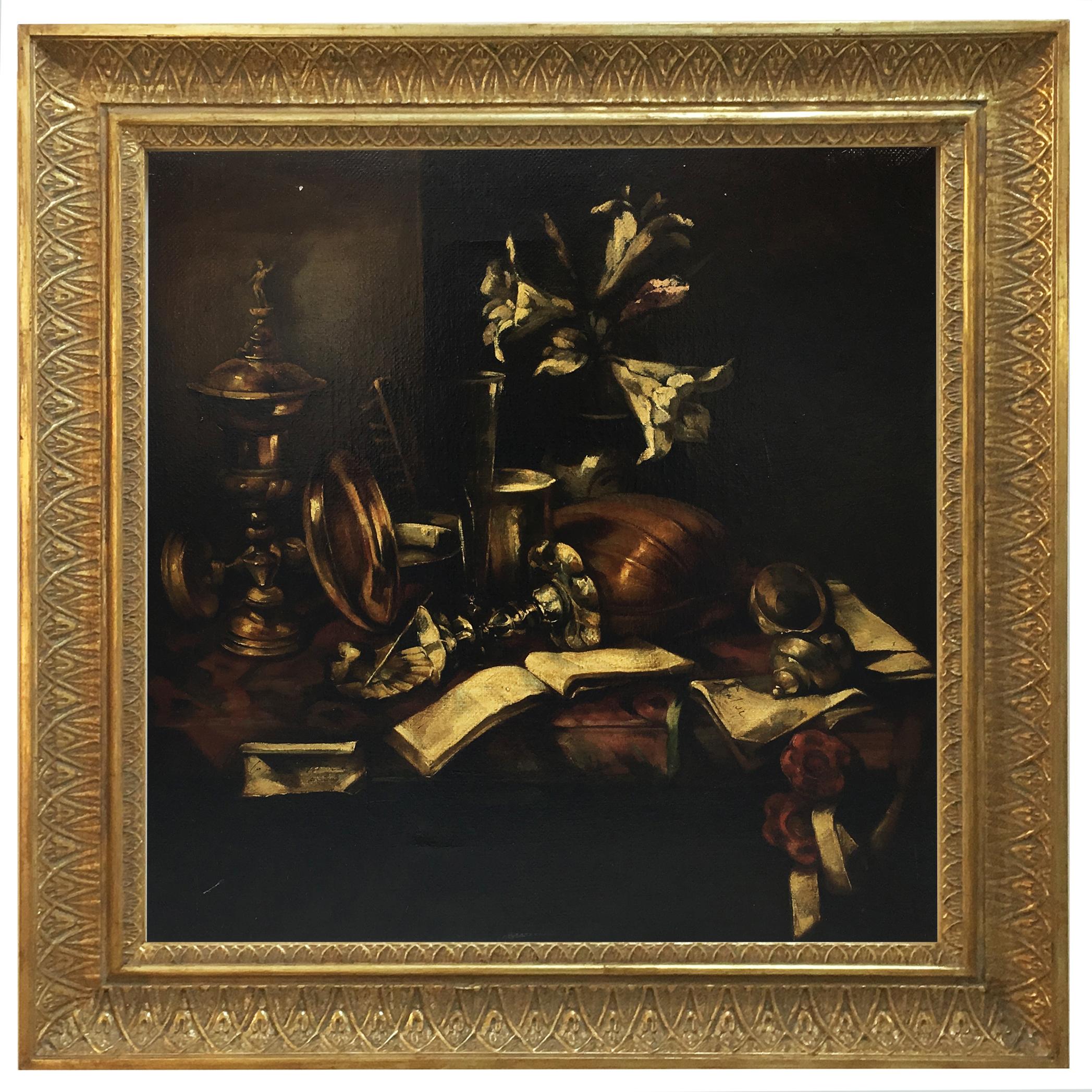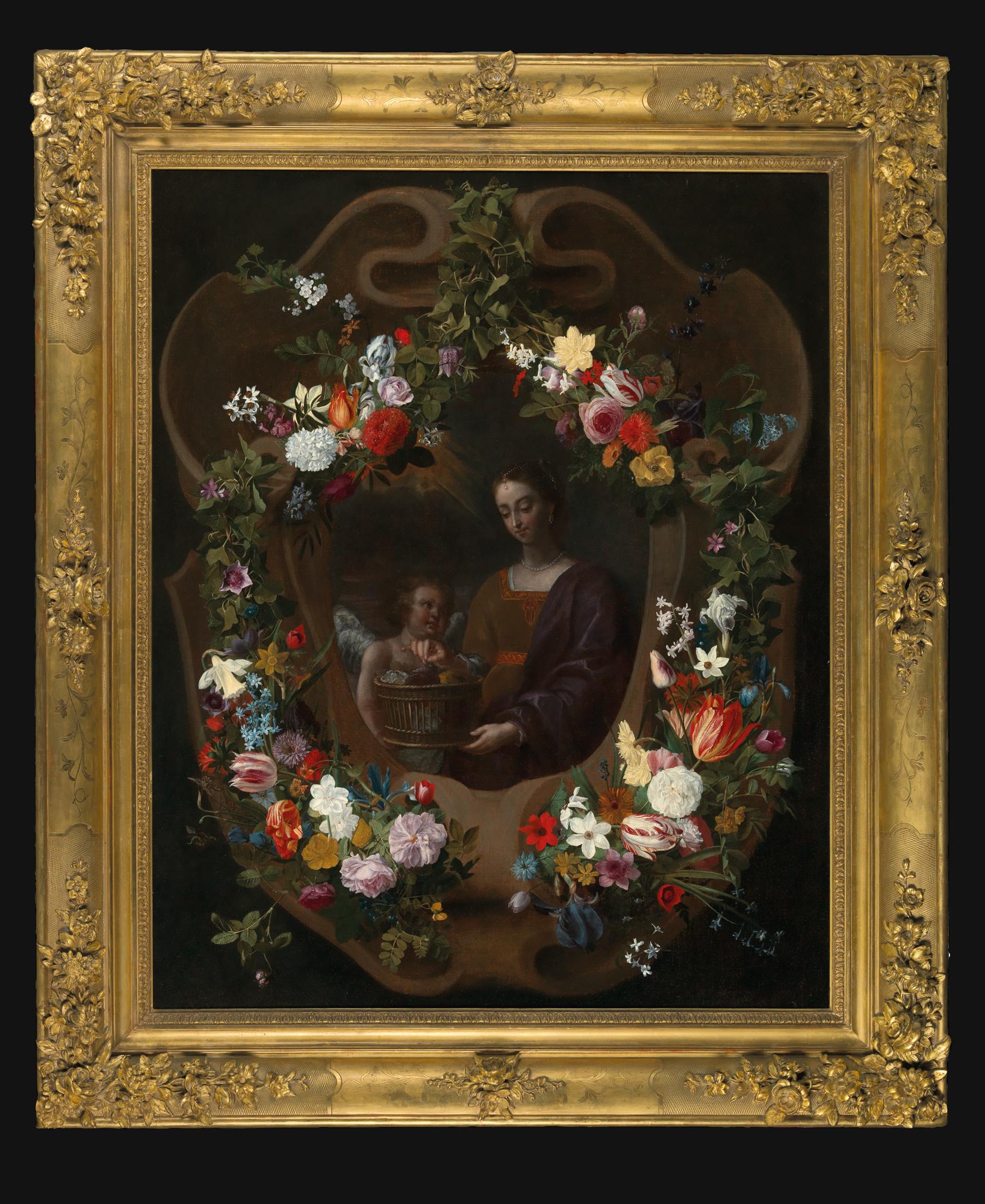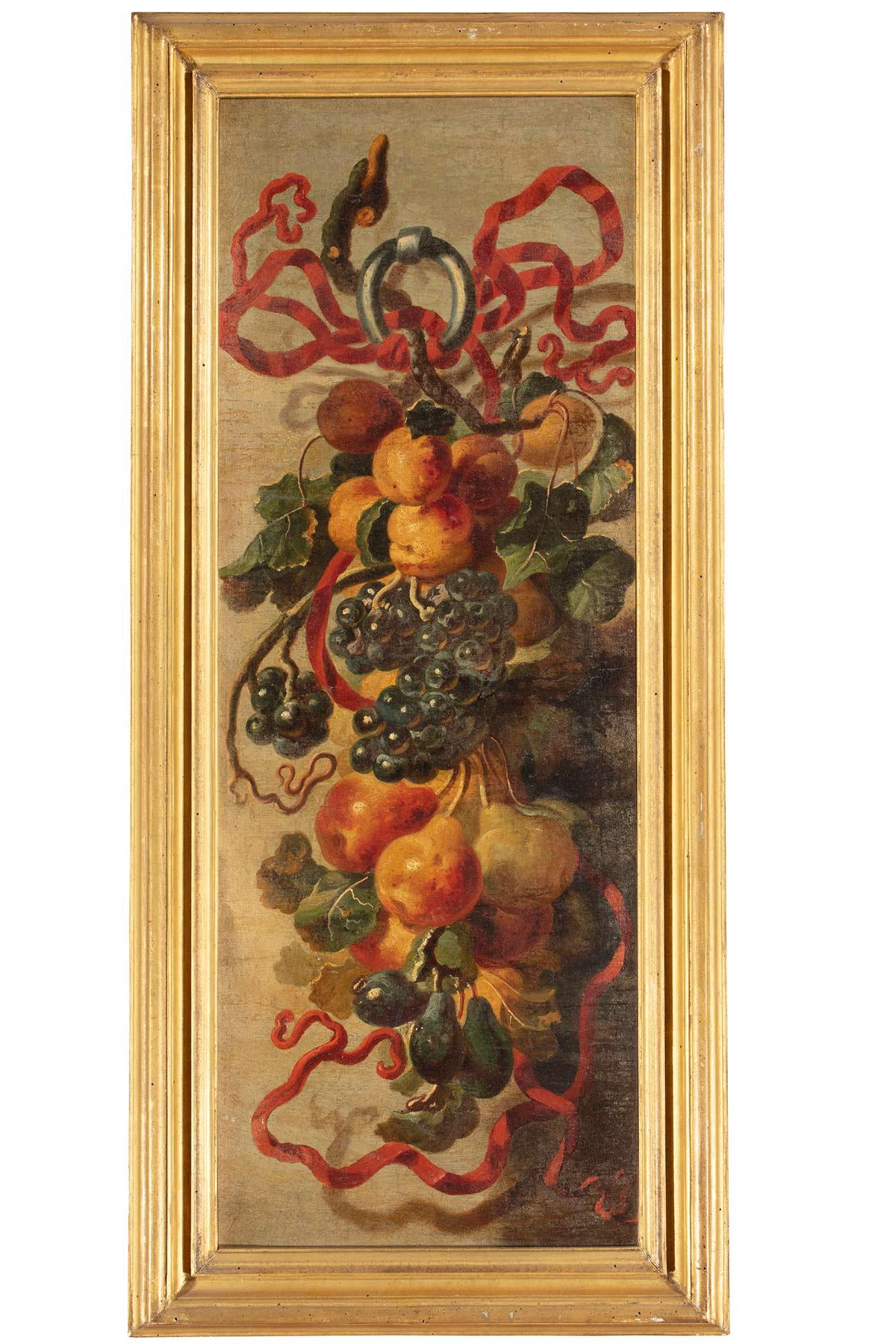Items Similar to De Wit Flowers Still life Paint Oil on canvas 18th Century Flemish Cupids Art
Want more images or videos?
Request additional images or videos from the seller
1 of 19
De Wit Flowers Still life Paint Oil on canvas 18th Century Flemish Cupids Art1720-1750
1720-1750
About the Item
Jacob De Wit (Amsterdam, 1695 - 1754) attributable/ workshop
Pair of Cupids with Garland of Flowers
Oil on canvas
91 x 103 cm. - Framed 104 x 115 cm.
Provenance: Christie's (London, Old master Painting 12.12.1996) lot 82
This magnificent composition depicts two cupids holding a garland of flowers, placed on a fine architecture with bas-reliefs and masks, presumably the top of a fountain.
One of the two cupids sympathetically holds a part of it with his hands, while his head turns towards the viewer; the second cupid, on the other hand, must have clumsily broken the thread holding its end, and is sitting sullenly with a torch and a tear streaking his chubby cheek.
The work, given its stylistic features and compositional taste, can be attributed to the Flemish artist Jacob de Wit (Amsterdam, 1695 - 1754), or to an artist from his workshop, with his typical triumphal and opulent style, which reveals clear influences from Rubens and Van Dijck, but also from Gerard de Lairesse and of course Gasper Pieter II Verbruggen.
After his apprenticeship in the workshop of Peter Paul Rubens, Jacob de Witt worked in Amsterdam, opening his own atelier there in 1716, where he obtained countless commissions, especially to decorate private homes and churches.
Pupils in his workshop include Jan de Groot, Elias van Nijmegen, Jan Punt, Pieter Tanjé and the brothers Franciscus and Jacob Xavery.
Our charming canvas allows us to better appreciate the decorative virtues of Jacob De Wit's painting: his art was particularly appreciated for the remarkable decorative verve he expressed by executing elegant compositions enlivened by putti and angels that became the most admired and sought-after pieces in his repertoire.
We can compare our canvas with a sketch drawn for a canvas, in a private collection (see fig. 1), made by de Wit's workshop, which resembles our painting in many details: we can see the same shape of the architectural construction and also the position of the little angels. It could therefore be identified as a preparatory drawing for the present painting.
fig.1
Preparatory drawing, Bottega J. De Wit, Private Collection
The elaborate composition with putti in various poses, the rich, warm colours and the use of trompe l'oeil effects achieved through the sculpture of the architecture are all characteristics for which De Wit's paintings became so famous and sought-after.
ADDITIONAL INFORMATION:
The work is sold complete with a nice gilded frame and is accompanied by a certificate of authenticity and descriptive iconographic card.
We take care of and organise the transport of the purchased works, both for Italy and abroad, through professional and insured carriers.
Contact us for any information, we will be happy to answer you. You can also see the painting in the gallery in Riva del Garda, we will be glad to welcome you and show you our collection of works.
- Attributed to:Jacob De Wit (Amsterdam, 1695 - 1754)
- Creation Year:1720-1750
- Dimensions:Height: 40.95 in (104 cm)Width: 45.28 in (115 cm)
- Medium:
- Movement & Style:
- Period:
- Condition:
- Gallery Location:Riva del Garda, IT
- Reference Number:1stDibs: LU988113651632
About the Seller
4.8
Platinum Seller
These expertly vetted sellers are 1stDibs' most experienced sellers and are rated highest by our customers.
Established in 2017
1stDibs seller since 2018
204 sales on 1stDibs
Typical response time: <1 hour
- ShippingRetrieving quote...Ships From: Riva del Garda, Italy
- Return PolicyA return for this item may be initiated within 7 days of delivery.
More From This SellerView All
- Flower Garland Virgin Paint Oil on canvas Old master 17th Century ItalyBy Giovanni StanchiLocated in Riva del Garda, ITGiovanni Stanchi (Rome 1608 - 1675) or Niccolò Stanchi (Rome 1623 - 1690), workshop of GARLAND OF FLOWERS WITH PORTRAIT OF THE VIRGIN Rome, First half of the Seventeenth century o...Category
17th Century Old Masters Paintings
MaterialsOil
- Still Lifes Flowers De Arellano Paint 17th Century Oil on canvas Old master ArtLocated in Riva del Garda, ITJosè de Arellano (Madrid, 1653 - c. 1714) attributable Pair of still lifes of flowers Oil on canvas 37 x 45 cm. - In period frames 50 x 59 cm. Pair of still lifes, each depicting a...Category
17th Century Old Masters Paintings
MaterialsOil
- Flower Still-life Virgin Trevisani Stanchi Paint Oil on canvas 17/18th CenturyBy Francesco Trevisani (Capodistria 1656 - Rome 1746)Located in Riva del Garda, ITFlower garland with a portrait of the Virgin Francesco Trevisani (Capodistria 1656 - Rome 1746) and Niccolò Stanchi (Rome 1623 - 1690), attributable Oil on canvas 66 x 49 cm. - In f...Category
18th Century Old Masters Still-life Paintings
MaterialsOil
- Still-life Flower Paint Oil on canvas Old master 17th Century Lombard schoolLocated in Riva del Garda, ITFrancesca Volò Smiller, called Vincenzina (Milan, 1657 - 1700) - circle of Floral composition Oil on canvas (97 x 72 cm. - in octagonal frame 100 x 84 cm.) A rich floral compositio...Category
17th Century Old Masters Paintings
MaterialsOil
- Still Life Vanitas Noletti Paint Oil on canvas Old master 17th Century ItalianLocated in Riva del Garda, ITFrancesco Noletti known as the Maltese (Malta 1611-Rome 1654) Workshop/circle of Still life with musical instruments, toys, armour, textiles and precious objects Oil on canvas (52 x...Category
17th Century Old Masters Paintings
MaterialsOil
- Angels Flower Garzi Paint Oil on canvas Old master 17/18th Century Italian ArtBy Luigi Garzi (Pistoia 1638– Rome1721)Located in Riva del Garda, ITRoman school of the early 18th century Luigi Garzi (Pistoia 1638– Rome1721) attributed Still life of fruit supported by three angels Oil on oval canvas 116 x 91 cm., Framed 140 x 119 cm. Authentication on a photograph by Prof Giancarlo Sestieri, who attributes the work to the sphere of Luigi Garzi This magnificent canvas, depicting a sumptuous composition of fruit supported by three prosperous winged cherubs, from which comes a parchment bearing the Latin expression "Amor est vitae essentia", is to be placed in the production of a Roman author active between the second half of XVII century and the first of the following century. The iconography that sees represented cherubs with fruit or flowers is frequent in the Baroque period, especially in the Roman area, starting from the 1600s, with that particular depictional tendency aimed at illusionistic and frivolous images, to a type of paintings or frescoes of strong value decorative, intended for the private context and depicting jubilation of cherubs, angels or cherubs, and of which our canvas represents a perfect example. We can recall, among the most illustrious iconographic precedents, the elegant mirrors painted by Mario Nuzzi and Carlo Maratta that adorn the hall of Palazzo Colonna in Rome, and again the canvas preserved in the Rouen museum and the similar ones in Palazzo Chigi in Ariccia, with the collaboration for the figurative parts of Filippo Lauri. The commercial and furnishing success of similar works is also testified by authors such as Guglielmo Cortese known as Borgognone (1628 - 1679), Franz Werner Von Tamm (1658 - 1724), Giovan Battista Gaulli (1639 - 1709), Giovanni Paolo Castelli known as Spadino (Rome 1650 - 1740) and the aforementioned Carlo Maratta (1625 - 1713) The work, studied by Giancarlo Sestieri, was brought closer to the sphere of the eclectic Pistoian painter Luigi Garzi, one of the protagonists of Roman painting in the decades of transition between the seventeenth and eighteenth centuries. In our painting we can find the typical elements of his painting: the soft and delicately chiaroscuro light, the sculptural classicism of the figures as well as the stupendous luministic and chromatic effects. Luigi Garzi's training and artistic activity took place in the Eternal City and he was in effect a Roman artist. He moved to Rome from Pistoia, his hometown at a very young age, and joined the atelier of Andrea Sacchi, who directed his studies towards classicism, comparing himself with the works of Raphael, Domenichino and Nicolas Poussin, but also with the Emilian one. , with particular attention to the school of Guido Reni. But the Emilian examples were undoubtedly preceded, particularly by Giovani Lanfranco, who modeled his taste and style, together with a modulated cortonism, while those pre-eighteenth-century sensibilities are due to the lesson of Carlo Maratta. However, there is no doubt that the painter oriented his personality without ever bowing to imitation, reaching a refined elegance and autonomy of language, as the canvas in question clearly demonstrates in which the different influences find a refined amalgamation in perfect harmony with the baroque evolution between the seventeenth and eighteenth centuries, indicating a dating to its earliest maturity. These attitudes led the painter to obtain awards and prestigious commissions as soon as possible, such as the frescoes of Palazzo Borghese...Category
Late 17th Century Old Masters Paintings
MaterialsOil
You May Also Like
- 18th Century by Francesco Lavagna Pair of Flower Vases Oil on CanvasLocated in Milano, Lombardia98 x 36 cm each without frame - 112 x 50 cm with frame Antique gilded and shaped wooden box frames Expertise by Prof. Giancarlo Sestieri This marvellous pair of flower vases has b...Category
Early 18th Century Old Masters Figurative Paintings
MaterialsCanvas, Oil
- Huge Classical Still Life Flowers & Fruit Still Life in Stone Urn Oil PaintingLocated in Cirencester, GloucestershireProfusion of Flowers by Thomas Webster, British contemporary artist, late 20th century signed oil on board, unframed board: 30 x 18 inches provenance: private collection, UK conditi...Category
Late 20th Century Old Masters Still-life Paintings
MaterialsOil
- Very Large Profusion of Flowers Classical Still Life Stone Urn Oil PaintingLocated in Cirencester, GloucestershireClassical Still Life of Flowers by Thomas Webster, British contemporary artist late 20th century signed oil on board, unframed board: 30 x 18 inches provenance: private collection, U...Category
Late 20th Century Old Masters Still-life Paintings
MaterialsOil
- Still Life - Francesca Strino Italian oil on canvas paintingBy Francesca StrinoLocated in Napoli, ITStill life - Francesca Strino Italia 2005 - Oil on canvas cm.60x60 Francesca Strino, a Neapolitan painter, realises this still life with great pictorial realism. The painter has her ...Category
Early 2000s Old Masters Still-life Paintings
MaterialsOil, Canvas
- Grand-Scale Old Master Garland Portrait, 17th Century, Signed & Dated, Rare workLocated in London, GBIndistinctly signed and dated In the first quarter of the 17th century a new form of flower painting was developed in Flemish painting, which, recreated by a large group of artists and workshops, would achieve considerable success throughout the century in much of Europe: the garland of flowers surrounding a central figure. Brueghel de Velurs was the initiator of this type of composition, however, it was his pupil, Daniel Seghers, who was the dominant figure in this specialised production and the creator of a prototype that would serve as a model for the numerous artists who followed in his wake. It seems undeniable that the artist of the present painting had seen the Garlands of Flowers Surrounding a Medallion Depicting the Triumph of Love by Daniel Seghers and Domenico Zampieri (now in the Musée du Louvre in Paris). In our painting, the present floral wreath encircles a carved cartouche within which sits Saint Dorothy of Caesarea and the attribute which often accompanies her in art, a basket of roses. The extremely delicate flowers have been rendered in meticulous detail, so that every species can be identified from exotic tulips to roses, irises and forget-me-nots; this obvious attention to naturalism is inherited from the Flemish manner. Each flower is so precise and refined that they are an individual study in their own right. The still-lifes are from the hand of Jan Anton van den Baren, with the central figures by another accomplished hand. Van den Baren’s arrangement of flowers would have delighted connoisseurs in both Flanders and in Vienna, where the impossibility of their all blooming at the same time of year would have been understood as a further statement of the wonder and beauty of the divine. Van den Baren worked first in Brussels, where he collaborated with Erasmus Quellinus II for the figures in his works, before moving with Archduke Leopold Wilhelm, his patron, to Vienna in 1656, where he instead worked with fellow Flemish émigré painter Nikolaus van Hoy. The iconography relates to an eighth century legend where she was presented a basket of roses by a child. In addition to the brilliance of his handling of still-lifes Van den Baren played an important art historical role as Director of Archduke Leopold Wilhelm’s Picture Gallery in Vienna, then one of the greatest collections in the world and the core of what was to become the present collection of the Kunsthistorisches Museum, Vienna. Van der Baren compiled an inventory of the collection in 1659, and his predecessor as Director of the Archduke’s Picture Gallery (when it was still housed in Flanders), David Teniers, depicted van der Baren (third from right) in his celebrated Archduke Leopold Willem in his gallery at Brussels, conserved at the Kunsthistorisches Museum. It is a shining example of the Flemish Baroque and is a very rare object indeed, considering there are only 14 paintings accepted as authentic works by this artist. We are grateful to Fred Meijer for confirming the attribution to Johannes Antonius van der Baren. A feature of this painting is its outstanding carved and gilded frame with a plethora of flowers and foliage. Titan Fine ArtCategory
17th Century Old Masters Portrait Paintings
MaterialsCanvas, Oil
- 17th Century by Giovanni Paolo Castelli Still Life Oil on CanvasBy Giovanni Paolo Castelli detto SpadinoLocated in Milano, LombardiaGiovanni Paolo Castelli called Spadino (Rome 1659 - Rome 1730) Still life Oil on canvas, cm. 81x31 - with frame cm. 92x41 Shaped and gilded wo...Category
Late 17th Century Old Masters Still-life Paintings
MaterialsCanvas, Cotton Canvas, Oil
Recently Viewed
View AllMore Ways To Browse
Antique Flower Art
Flower Oil Paint
Amsterdam Art
Oil On Canvas Paint London
Turn Canvas Art
Painting Amsterdam
Paintings Of Amsterdam
Art Flemish
Old Amsterdam
Flower Head Art
Antique Gilded Frame Art
Amsterdam Oil Painting
Oil Painting Amsterdam
Antique Art Paintings Pairs
Framed Antique Flower Oil Paintings
Amsterdam 18th
Old Master Flowers
Amsterdam Oil On Canvas





